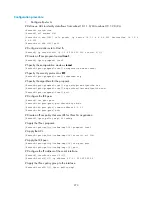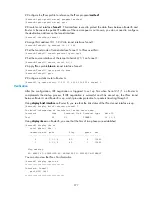
280
[RouterA-ipsec-proposal-tran1] encapsulation-mode transport
[RouterA-ipsec-proposal-tran1] transform esp
[RouterA-ipsec-proposal-tran1] esp encryption-algorithm des
[RouterA-ipsec-proposal-tran1] esp authentication-algorithm sha1
[RouterA-ipsec-proposal-tran1] quit
# Create an IPsec policy named
policy001
, specify the manual mode for it, set the SPIs of the inbound
and outbound SAs to
123456
, and the keys for the inbound and outbound SAs using ESP to
abcdefg
.
[RouterA] ipsec policy policy001 10 manual
[RouterA-ipsec-policy-manual-policy001-10] proposal tran1
[RouterA-ipsec-policy-manual-policy001-10] sa spi outbound esp 12345
[RouterA-ipsec-policy-manual-policy001-10] sa spi inbound esp 12345
[RouterA-ipsec-policy-manual-policy001-10] sa string-key outbound esp abcdefg
[RouterA-ipsec-policy-manual-policy001-10] sa string-key inbound esp abcdefg
[RouterA-ipsec-policy-manual-policy001-10] quit
# Apply IPsec policy
policy001
to the RIPng process.
[RouterA] ripng 1
[RouterA-ripng-1] enable ipsec-policy policy001
[RouterA-ripng-1] quit
2.
Configure Router B.
# Assign an IPv6 address to each interface. (Omitted)
# Create a RIPng process, and enable it on GigabitEthernet 1/0/1 and GigabitEthernet 1/0/2.
<RouterB> system-view
[RouterB] ripng 1
[RouterB-ripng-1] quit
[RouterB] interface gigabitethernet 1/0/1
[RouterB-GigabitEthernet1/0/1] ripng 1 enable
[RouterB-GigabitEthernet1/0/1] quit
[RouterB] interface gigabitethernet 1/0/2
[RouterB-GigabitEthernet1/0/2] ripng 1 enable
[RouterB-EGigabitthernet1/0/2] quit
# Create an IPsec proposal named
tran1
, and set the encapsulation mode to transport mode, the
security protocol to ESP, the encryption algorithm to DES, and authentication algorithm to SHA1-HMAC-
96.
[RouterB] ipsec proposal tran1
[RouterB-ipsec-proposal-tran1] encapsulation-mode transport
[RouterB-ipsec-proposal-tran1] transform esp
[RouterB-ipsec-proposal-tran1] esp encryption-algorithm des
[RouterB-ipsec-proposal-tran1] esp authentication-algorithm sha1
[RouterB-ipsec-proposal-tran1] quit
















































